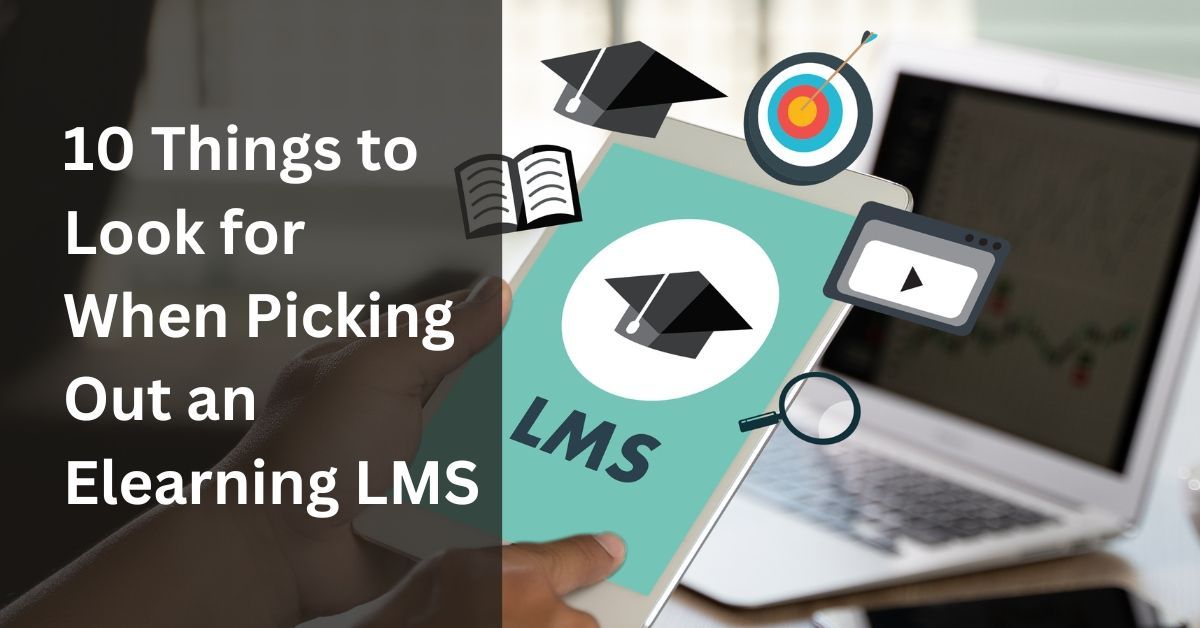10 Things to Look for When Picking Out an Elearning LMS

In today’s rapidly evolving corporate training landscape, the role of a Learning Management System (LMS) has become increasingly crucial for organizations seeking to deliver effective and engaging eLearning experiences to their employees. An LMS serves as the foundation for a successful eLearning strategy, providing the tools and functionality needed to manage, deliver, and track online training programs.
What is an LMS?
A Learning Management System (LMS) is a software application designed to administer, document, track, report, and deliver online educational courses and training programs. It serves as a centralized hub for managing the entire learning lifecycle, from content creation and course enrollment to learner progress tracking and reporting.
In the context of eLearning, an LMS provides the necessary infrastructure and tools to create, distribute, and monitor digital learning experiences, enabling organizations to streamline their training efforts, improve learner engagement, and enhance the overall effectiveness of their corporate training programs.
What Are 10 Key Factors to Consider When Choosing an Elearning LMS?
1. User-Friendly Interface
The user experience of the LMS is crucial, as it directly impacts both learner engagement and administrative efficiency. Look for an intuitive, visually appealing interface that is easy to navigate, with clear menus, streamlined course organization, and a responsive design that works seamlessly across desktop and mobile devices.
2. Content Creation and Management
A comprehensive LMS should provide a powerful content management system, allowing administrators to easily upload, organize, and manage a variety of learning materials. This includes features like version control, content tagging, and the ability to create custom learning paths and curricula. Effective content management ensures learners can access the resources they need while administrators maintain quality and consistency.
3. Personalized Learning Experiences
Consider the LMS’s ability to deliver personalized learning experiences. Look for features like adaptive learning, which adjusts the content and difficulty level based on learner performance, as well as recommendation engines that suggest relevant courses or learning materials based on individual needs and preferences.
4. Integrations and Interoperability
Assess the LMS’s ability to integrate with other enterprise systems, such as HR, CRM, and collaboration tools. Seamless integrations can enhance data sharing, streamline administrative tasks, and create a cohesive learning ecosystem for your organization.
5. Gamification and Microlearning
Engaging learners is vital for the success of your eLearning initiatives. Assess the LMS’s gamification features, like points, badges, and leaderboards, as well as its support for microlearning, which enables the delivery of bite-sized, easily digestible content. This approach is ideal for employee upskilling and training, fitting seamlessly into their busy schedules.
6. Reporting and Analytics
Robust reporting and analytics capabilities are essential for measuring the impact of your eLearning programs and making data-driven decisions. Look for an LMS that offers customizable dashboards, detailed course completion reports, and the ability to track and analyze key performance indicators like learner engagement, progress, and knowledge retention.
7. Mobile Accessibility
In today’s mobile-centric world, it’s important to ensure that your eLearning content and LMS platform are accessible on-the-go. Prioritize LMS solutions that provide a responsive, mobile-friendly design, enabling learners to access training materials and engage with the platform seamlessly from their smartphones and tablets.
8. Collaborative Learning
Look for an LMS that facilitates collaborative learning, allowing your employees to engage in discussions, share knowledge, and work on projects together. Features such as discussion forums, group assignments, and the ability to comment on learning materials can enhance peer-to-peer learning and knowledge sharing.
9. Compliance and Certification Management
If your organization operates in a regulated industry, evaluate the LMS’s compliance and certification management features. This may include automated course enrollment, compliance reporting, and the ability to track and manage employee certifications and recertification deadlines.
10. Scalability and Continuous Improvement
As your organization grows and your training needs evolve, ensure that the LMS you choose is scalable and designed for continuous improvement. The platform should be able to accommodate increasing user numbers, support new content types, and provide the flexibility to adapt to changing requirements over time. Additionally, look for an LMS vendor that is committed to regularly updating the platform and responding to user feedback.
In Conclusion
Selecting the appropriate LMS software for your educational needs involves thorough consideration of these key factors. By prioritizing user experience, compatibility, customization, and support, you can ensure that your chosen system will effectively enhance the learning experience. If you’re specifically looking for solutions tailored to educational institutions, consider checking out lms software for schools in London, UK to find systems designed to meet the unique challenges and requirements of school environments. With the right LMS, you can create a dynamic and engaging learning environment that supports student success.
Article /
10 Things to Look for When Picking Out an Elearning LMS
Realted Article


You Might Also Like This









